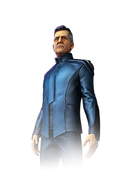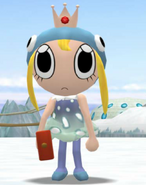(Clans do not constitute subspecies!) Tag: Source edit |
(Adding categories) |
||
| (17 intermediate revisions by 10 users not shown) | |||
| Line 4: | Line 4: | ||
|image = [[File:The City on the Edge of Forever.jpg]] |
|image = [[File:The City on the Edge of Forever.jpg]] |
||
|binomen = ''Homo sapiens'' |
|binomen = ''Homo sapiens'' |
||
| − | |other = Hume<br>Earthling<br>Tellurian<br>Terran<br>Gaian<br>Mortal<br>Midgardian<br>Hairless ape<br>Man<br>Mankind<br>Humankind<br>Anthropoid<br>Earther<br>Earthman (male)<br>Earthwoman (female)<br>Earthgirl (female) <br>Tunnel Ape <br>Softie <br>Tau'ri |
+ | |other = Hume<br>Earthling<br>Tellurian<br>Terran<br>Gaian<br>Mortal<br>Midgardian<br>Hairless ape<br>Man<br>Mankind<br>Humankind<br>Anthropoid<br/>Earthians<br>Earther<br>Earthman (male)<br/>Earthboy (male)<br>Earthwoman (female)<br>Earthgirl (female) <br>Tunnel Ape <br>Softie <br>Tau'ri |
|world = Earth |
|world = Earth |
||
|habitat = Tropics (formerly)<br>Worldwide (currently) |
|habitat = Tropics (formerly)<br>Worldwide (currently) |
||
| Line 13: | Line 13: | ||
|locomotion = Bipedal |
|locomotion = Bipedal |
||
|diet = Omnivorous |
|diet = Omnivorous |
||
| − | |lifespan = |
+ | |lifespan = 60 to 80 Earth-years (average) <br> 122 Earth years (oldest ever) |
|sapience = Sapient |
|sapience = Sapient |
||
|behavior = Variable hostility |
|behavior = Variable hostility |
||
| Line 67: | Line 67: | ||
==In popular culture== |
==In popular culture== |
||
| − | Human civilizations have been featured in various ways in an extraordinarily large number of works |
+ | Human civilizations have been featured in various ways in an extraordinarily large number of works. |
| − | * ''Final Fantasy'' |
||
| − | * ''Warcraft'' |
||
| − | * ''Dungeons & Dragons'' |
||
| − | * ''The Elder Scrolls'' |
||
| − | * ''Naruto'' |
||
| − | * ''Destiny'' |
||
| − | * ''Mass Effect'' |
||
| − | * ''Monster Hunter'' |
||
| − | * ''Mobile Suit Gundam'' |
||
| − | * ''Runescape'' |
||
| − | * ''Star Wars'' |
||
| − | * ''Star Ocean'' |
||
| − | * ''Foundation'' |
||
| − | * Anime |
||
| − | * Books |
||
| − | * Video Games |
||
| − | * Nintendo |
||
| − | * And many others... |
||
In science fiction and fantasy settings, Humans may be portrayed as anything from a planetary civilization to an interplanetary, interstellar or even intergalactic one. |
In science fiction and fantasy settings, Humans may be portrayed as anything from a planetary civilization to an interplanetary, interstellar or even intergalactic one. |
||
| Line 124: | Line 106: | ||
[[Category:Force-Sensitive Species]] |
[[Category:Force-Sensitive Species]] |
||
[[Category:Mandalorians]] |
[[Category:Mandalorians]] |
||
| − | [[Category: |
+ | [[Category:Simian Species]] |
| + | [[Category:Religious Races]] |
||
| + | [[Category:Species with Binocular Vision]] |
||
| + | [[Category:Bipedal Species]] |
||
Revision as of 02:21, 16 June 2021
- "Homo sapiens; what an inventive, invincible species. It's only a few million years since they crawled up out of the mud and learned to walk. Puny, defenseless bipeds. They've survived flood, famine and plague. They've survived cosmic wars and holocausts. And now, here they are, out among the stars, waiting to begin a new life. Ready to out sit eternity. They're indomitable!"
- ―The Doctor (The Ark in Space)
Humans (Homo sapiens) are a species of bipedal sapient beings native to planet Earth. They are omnivorous and generally believed to have descended from arboreal ancestors.
Biology
Humans have an erect posture, with two legs, two arms and a head which comprises the brain and most of the sense organs. Extraterrestrial species showing this same body plan, or a very similar one, are collectively known as humanoids. Although some humanoid races look almost exactly like humans (probably due to convergent evolution), as is the case with Vulcans, they are often very different internally. Vulcans, for example, have green blood containing copper, while the Human blood is red and contains iron.
| Constituent | Weight | Percentage of atoms |
| Oxygen | 38.8 kg | 25.5 % |
| Carbon | 10.9 kg | 9.5 % |
| Hydrogen | 6.0 kg | 63.0 % |
| Nitrogen | 1.9 kg | 1.4 % |
| Other | 2.4 kg | 0.6 % |
Humans are carbon-based lifeforms, and have an internal skeleton containing calcium phosphate, which gives the bones strength and durability. More than 60% of the Human body is composed of liquid water. Their circulatory system is closed and they have a heart and two lungs (though they are able to survive with only one lung), located in the chest area.
Humans have two pairs of limbs, the lower pair adapted for bipedal walking (legs) and the upper for carrying (arms).
Human arms end in hands. Hand are intricate arrangements of five miniature limbs that can be used as grapples, tweezers, clusters of feelers, baskets or semaphore machines. (Aliens often mistake human hands for symbiotic lifeforms on first contact: hands appear to have four limbs and a head, like the main body of the human; the hands operate machinery and perform all the recognizably intelligent actions, and the hands attempt to communicate in some sort of interpretive dance.)
Humans balance vertically on their legs. Human knees bend backwards. Human feet evolved from a second pair of hands, the feet can bear the human's weight, but cannot perform any of the actions of the true hands. However, though, hence, humans have also developed sufficiently to perform tasks using their feet as a matter of choice and need in place of the hands where absent.
Despite having evolved as a predatory species, Humans are generally considered weak and not well adapted to hunt without the aid of tools. Their canine teeth, for example, are not sharp like those of their evolutionary relatives, the other Earth primates, and their fingers and toes have nails, rather than claws. They can, however throw objects with unusual strength and accuracy, and an athletic human is a tireless runner. A human following you with a rock is extremely dangerous.
Humanity's greatest strength is their endurance. Being pursuit predators by nature, humans have several adaptations for such a lifestyle such as sweat glands and being mostly bare of hair. Even when compared to other Terran pursuit predators like wolves, a human's endurance is massive. With this endurance comes hardiness. Injuries such as broken limbs or large lacerations are often death sentences for other species while humans oftentimes live several years after receiving similar injuries though, thanks to their hyperactive scar tissue, leaves nasty scars. In hybrids with other sapient species, this adaptability lessens or completely removes any inherited weaknesses.
In popular culture
Human civilizations have been featured in various ways in an extraordinarily large number of works.
In science fiction and fantasy settings, Humans may be portrayed as anything from a planetary civilization to an interplanetary, interstellar or even intergalactic one.
Humans in science fiction may also be known as Earthlings, Terrans or Tellurians. The Real People from Joan D. Vinge's "The Crystal Ship" refer to Humans as the "Star People"; whereas the Traags from Fantastic Planet call them "Oms", and regard them as little more than pests. In the Sector General universe, every sapient species calls itself "human" in its native tongue, thus requiring the descriptor "Earth-Human", or using the physiological classification for humanoids in general: "DBDG".
Some works of fiction have portrayed Humans as descendants of some extraterrestrial species that once settled on Earth, e.g.: the Pak Protectors in Known Space or the Golgafrinchans in The Hitchhiker's Guide to the Galaxy; or as the product of artificial experimentation on Earth's lifeforms, either intentional or unintentional, such as that which was conducted by the Silurians in Doctor Who, or by the Elder Things in H. P. Lovecraft's "Cthulhu Mythos". In the Space Odyssey series, Humans achieved sapience under the influence of an alien Monolith.
Additionally, the social and technological development of Humans may have been influenced or guided by alien interference, e.g.: the Vorlons from Babylon 5; a Salaxalan pilot from Dirk Gently's Holistic Detective Agency; or the Silents from Doctor Who.
Conversely, humans themselves are generally regarded as the ancestors of a large number of species and are often capable of interbreeding with many as well.
In the works of science fiction author Isaac Asimov (when they feature aliens at all), Humans are often portrayed as a unique species among aliens in some aspect or another. In "The Hostess", Humans are the only intelligent species to walk bipedally, and the only one to be omnivorous. They're also the only species which needs to sleep and has the ability to dream, and the only one with a biologically-finite lifespan. Humans are the only ape-derived species not to end up devastated by a nuclear war in "The Gentle Vultures"; the only species to which group psychology is applicable in "Homo Sol" and its sequels; and the only species in the galaxy which reproduces sexually in "What Is This Thing Called Love?".

